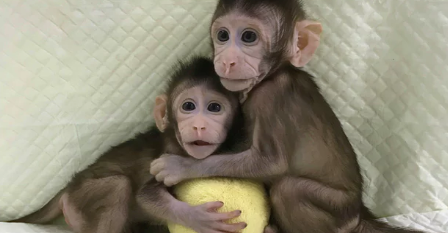http://1.bp.blogspot.com/-2lDjfIpLU_s/Wmlm1rvr7DI/AAAAAAAAOHw/NmgrU8Jdy6QWLLb_LjxMRPvdGofjQNQwACK4BGAYYCw/s1600/2018-01-25_10-39-30.png

Two baby macaque monkeys have become the first primate clones to be produced using the same approach that gave rise to Dolly the sheep, researchers have revealed.
Big eyed, fuzzy-furred and spindly-limbed, the macaques have been named Zhong Zhong and Hua Hua. Zhonghua is the official name for China, where the animals were born.
The researchers behind the development say it will allow scientists to compare macaques to others that are genetically identical except for particular genes that have been deliberately tinkered with. That, they add, will not only help researchers probe the mechanisms behind human diseases, but aid drug screening and the development of other therapeutics.
“[The] first group of monkey clones will be models for neurodegenerative diseases,” Dr Mu-ming Poo, co-author of the research and director of the Chinese Academy of Sciences’ Institute of Neuroscience, told the Guardian. He added that the clones could also help scientists probe how the behaviour of identical twins’ genes becomes more dissimilar over time as environmental modifications to their DNA build up.
Macaque monkey clones have previously been produced by splitting an embryo, similar to the way identical twins arise in nature. But the latest research makes use of a different technique known as somatic cell nuclear transfer (SCNT) – an approach that was used to produce Dolly the sheep in 1996.
This technique involves removing the nucleus from an unfertilised egg and replacing it with that from a cell taken from the body of the individual to be cloned. This is done by fusing the cell with the nucleus-free egg – a process achieved using an electric current in the case of Dolly, and part of a virus in the latest research. The resulting embryo is transferred into a surrogate mother.
So far the technique has been used to clone a menagerie of animals, including sheep, cattle, cats, mice and even dogs – the first clone of which was an Afghan hound puppy named Snuppy.
One difficulty in the approach lies in “reprogramming” the donor nucleus – a mechanism by which existing modifications to the DNA, or proteins attached to the DNA, are erased before new changes are made, allowing it to give rise to all of the different types of cells in the body.
With the issue thought to have been a key barrier in previous attempts to clone non-human primates using SCNT, the team behind the new study describe how they exposed the egg with the “new” nucleus to a cocktail of different substances which aided reprogramming, and hence the development of the embryo.
Writing in the journal Cell, the team describe how they used the technique with two different sources of nuclei – cells from an aborted macaque foetus, and cells surrounding the eggs of an adult macaque.
In total 79 embryos produced using cells from the foetus were implanted into 21 surrogates, resulting in two live baby monkeys, born by caesarean section: Zhong Zhong and Hua Hua. Using adult macaque cells as a source of nuclei, 181 embryos were implanted into 42 surrogates and again two live babies were delivered – but both died shortly after birth, possibly because of greater difficulties in reprogramming the genes.
The team say the technique is preferable to splitting an embryo, since the latter can only produce a small number of clones, and it is difficult to edit genes in the embryos with precision.
“Cloning by SCNT solves these problems,” said Poo, noting that the technique not only means a large number of clones could be produced, but that any gene editing could be done before the nuclei are inserted into the eggs.
The researchers add that while the new research brings the possibility of cloning humans closer, it is not on the table.
“There is now no barrier for cloning primate species, thus cloning humans is closer to reality,” said Poo. “However, our research purpose is entirely for producing non-human primate models for human diseases; we absolutely have no intention, and society will not permit, this work to be extended to humans.”
Robin Lovell-Badge, a group leader at the Francis Crick institute in London and expert in genetics who was not involved in the study, said cloned animals were useful in research, since it removed the problem of genetic variability, allowing the impact of a drug or procedure to be more precisely examined. “The alternative of course, which is often what you have to do, is use many more animals,” he said.
But, Lovell-Badge added, given the success of somatic cell nuclear transfer in other animals, it was not surprising that the method worked in macaques. He is also doubtful as to whether the approach offers benefits over embryo splitting, given how few live babies were produced.
“This is so inefficient, so hazardous and unsafe, that I am not sure it is really justified, to be honest,” he said.
guardian.co.uk © Guardian News & Media Limited 2010
Published via the Guardian News Feed plugin for WordPress.
Zhong Zhong and Hua Hua: first primates born using Dolly the sheep cloning methodhttps://goo.gl/4k5VUx











0 comments:
Post a Comment